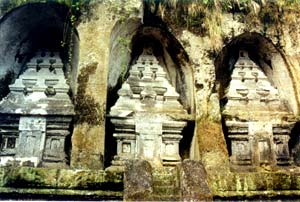|
Gunug Kawi is an ancient rocky temple situated in Pakerisan
River, near Tampaksiring village - Gianyar Regency in Bali.
This archaeological complex is carved out of the living
rock, dating back to 11th century. The temple with majesty
and richness in history has been proposed by Governor of
Bali to be listed on the World Heritage Sites.
The countryside where the complex is located offers beautiful
view of lush and footpath down to reach the temple, passing
through spectacular rice terraces. The appealing, mystifying,
and magnifying natural sceneries from the footpath, which
leads from the road down to the temple will be more impressive,
with the sound of water trickling along the irrigation channels
at the bottom of a valley. The only sound you hear is that
produced by farmers who work on their rice fields.
To reach the complex, visitors must walk about 600 meters
from the parking lot to the ticket counter then walked down
on approximately 315 stone steps. Before taking a cross
on the bridge at the bottom of the valley, you can see the
first stone monument. Another group of stone monument is
carved on the left side of the main temple across the river.
 The
monuments are shaped in relief on a solid rock hill, commonly
called "candi". There are shaped like burial towers,
telling identity of the royal personages honored here. Those
are mostly found all over Central and East Java. The
monuments are shaped in relief on a solid rock hill, commonly
called "candi". There are shaped like burial towers,
telling identity of the royal personages honored here. Those
are mostly found all over Central and East Java.
As the sources from any historical books about Bali and
related to the information given by the temple's care taker,
Ketut Raharja suggested that Those five 'candi' in the main
group were built for King Udayana, his Javanese queen Gunapriya,
his concubine, his illustrious eldest son Airlangga who
ruled over East Java, and his youngest son Anak Wungsu.
Reigning over Bali from AD 1050 to 1077, Anak Wungsu is
believed to have given up his kingdom to become a religious
hermit.
In the right of the main ensemble of temples is a cloister
with five cells carved out of rock. The cloister inmates
most likely were caretakers of the 'candi'. There's a second
hermitage near the main cloister, consisting of niches around
a central courtyard, which might have served as sleeping
quarters for visiting pilgrims. To get into this part of
the temple visitors must take off their shoes.
Being in the center area, where "candi" are carved,
you might feel that you were reborn back to the past. It
is impossible to capture all the surrounding beauty found
in this spot on film. And you could easily imagine living
here in peaceful and tranquil setting, getting along with
the local people who sell craft items along the footpath.
Other tourism spots proposed to be added to the List of
World Heritage Sites include Taman Ayun Palace Temple in
Mengwi - Badung Regency, the Bali Barat National Park in
West of Bali - Jembrana Regency, and Paddy Fields at Jatiluwih
- Tabanan Regency.
| 






